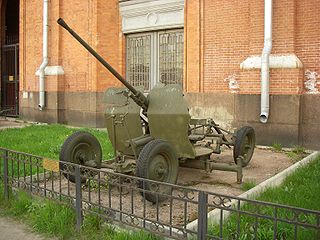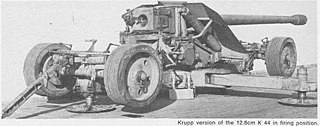
The 8.8 cm KwK 36 was an 88-millimetre (3.5 in) tank gun used by the German Army during World War II. This was the primary armament of the PzKpfw VI Tiger I tank. It was developed and built by Krupp.

The 8.8 cm Flak 18/36/37/41 is a German 88 mm anti-aircraft and anti-tank artillery gun, developed in the 1930s. It was widely used by Germany throughout World War II and is one of the most recognized German weapons of the conflict. The gun was universally known as the Acht-acht ("eight-eight") by the Germans and the "eighty-eight" by the Allies. Due to its lethality, especially as a tank killer, the eighty-eight was greatly feared by Allied soldiers.

The Flak 30 and improved Flak 38 were 20 mm anti-aircraft guns used by various German forces throughout World War II. It was not only the primary German light anti-aircraft gun but by far the most numerously produced German artillery piece throughout the war. It was produced in a variety of models, notably the Flakvierling 38 which combined four Flak 38 autocannons onto a single carriage.

The Pak 43 was a German 8.8 cm anti-tank gun developed by Krupp in competition with the Rheinmetall 8.8 cm Flak 41 anti-aircraft gun and used during World War II. The Pak 43 was the most powerful anti-tank gun of the Wehrmacht to see service in significant numbers, also serving in modified form as the 8.8 cm KwK 43 main gun on the Tiger II tank, the open-top Nashorn and fully enclosed, casemate-hulled Elefant and Jagdpanther tank destroyers.

25 mm automatic air defense gun M1940 (72-K) was a Soviet 25 mm caliber anti-aircraft gun used during the World War II. The gun was developed from the end of 1939 to the beginning of 1940 at 8th Kalinin Artillery Plant under the guidance of its Chief Designer Mikhail Loginov, supervised by Lev Loktev. The cannon was given the factory code 72-K before being accepted into service by the Red Army as the 25 mm automatic air defense gun M1940.

The 12.8 cm Pak 44 is a German anti-tank gun used during World War II. It was designed as a result of experiences on the Eastern front in 1943. The German Army came upon the Soviet 122 mm field guns and issued a requirement for a similar weapon. Development initially concentrated on a field gun known as the Kanone K 44. However, once heavier Soviet tanks such as the IS-2 started to appear, the design requirements were altered to include an anti-armour role.

The 8 cm Feldkanone M.5 was a field gun used by Austria-Hungary during World War I. It was a conventional design, with its most notable feature being its obsolescent autofrettaged bronze barrel, necessary because Austria-Hungary still had trouble making steel of the proper quality.

The 12.8 cm FlaK 40 was a German anti-aircraft gun used in World War II. Although it was not produced in great numbers, it was reportedly one of the most effective heavy AA guns of its era.

The 8.8 cm Flak 16 was a German 8.8 cm anti-aircraft gun from World War I, forerunner of the 8,8 cm FlaK/PaK Flak 18/36/37 of World War II. Its contemporary name was the 8,8 cm K.Zugflak L/45.

The Canon de 75 antiaérien mle 1913–1917 were a family of French 75 mm anti-aircraft guns designed and manufactured by Schneider et Cie at Le Creusot. The guns were used by the French Army during the First World War and Second World War.

The 9 cm Kanone C/73 was a field gun developed after the Franco-Prussian War and used by Germany before and during World War I.

The 7.62 cm FlaK L/30 was a German 76.2 mm anti-aircraft gun produced by Krupp during the First World War.

The 9 cm Kanone C/79 was a fortress and siege gun developed after the Franco-Prussian War and used by Germany before and during World War I.

The 12 cm Kanone C/80 was a fortress and siege gun developed after the Franco-Prussian War and used by Germany before and during World War I.

The 3.7 cm SockelFlak L/14.5 was an early German light anti-aircraft gun deployed in limited numbers towards the end of the First World War.

The 7.7 cm Leichte Kraftwagengeschütze M1914 was an early German self-propelled anti-aircraft gun developed before and used during the First World War. Static and trailer mounted versions of the gun were designated 7.7 cm FlaK L/27.

The 15 cm Ring Kanone C/92 was a fortress and siege gun developed in the 1880s that saw service in the Italo-Turkish War, Balkan Wars, and World War I.

The 8 cm Kanone C/80 was a field gun developed during the late 1800s by Krupp for the export market. It saw action in numerous regional conflicts as well as World War I.






















